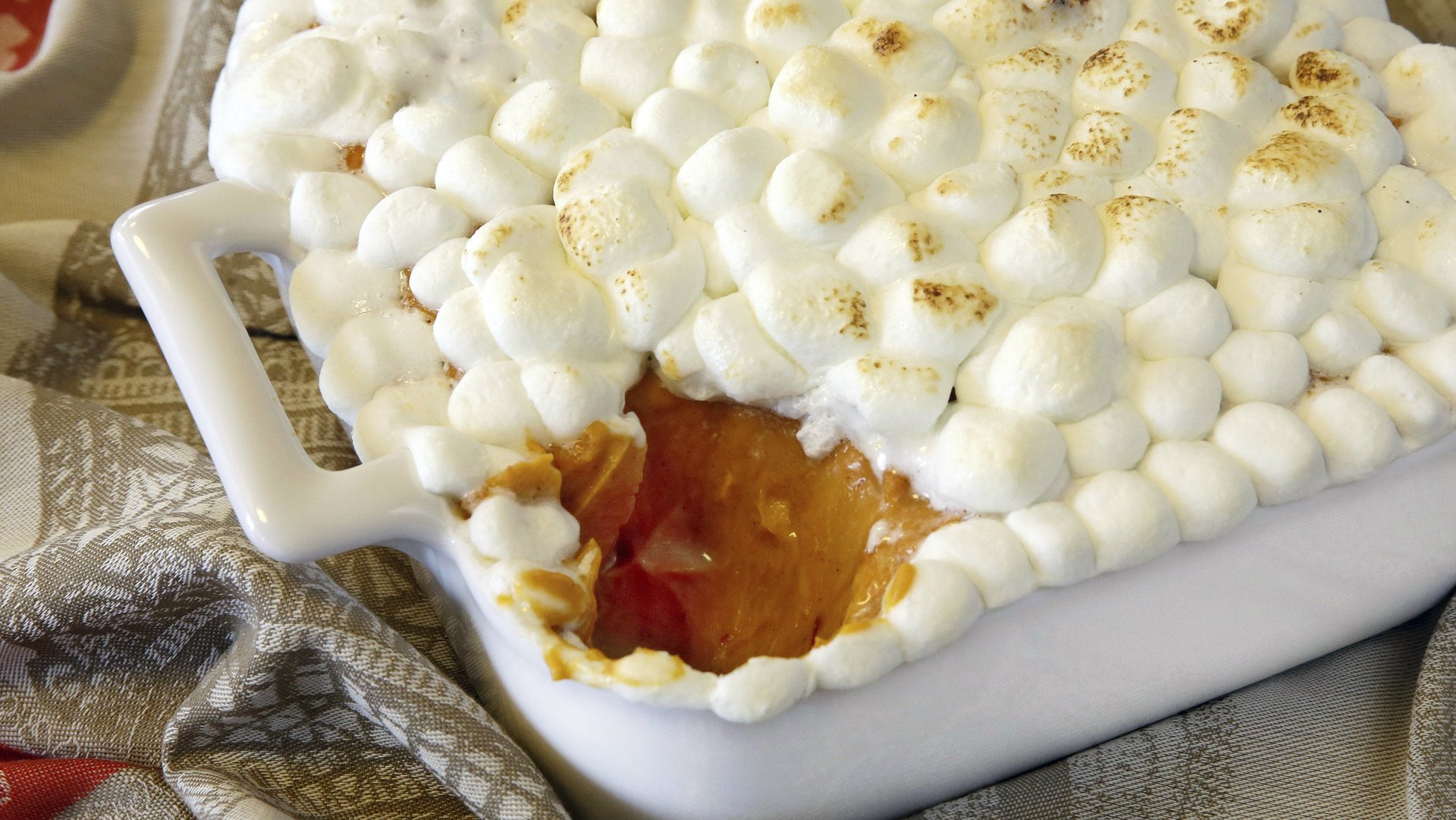The sweet potato casserole is Thanksgiving’s weirdest—and most American—dish
Is there any dish more reviled and revered than the sweet potato marshmallow casserole? Each Thanksgiving, it appears on Americans’ dining room tables for its annual cameo, to the delight of some and the disgust of others.


Is there any dish more reviled and revered than the sweet potato marshmallow casserole? Each Thanksgiving, it appears on Americans’ dining room tables for its annual cameo, to the delight of some and the disgust of others.
But how, and why, did Americans begin eating this highly divisive concoction?
Thanksgiving is full of muddled origin stories. (Every American elementary school student will remember the suspiciously rosy version of events presented as the “first Thanksgiving”—and how it notably failed to mention the decimation of Native American populations alongside the corn and turkey). But thanks to a cookbook published in 1917, we have a pretty good idea of who came up with the idea to put marshmallows on top of sweet potatoes. True to the spirit of capitalism, the people behind the recipe were marshmallow manufacturers themselves.
Angelus Marshmallows—the same folks who invented Cracker Jacks—invented the mass-produced marshmallow in 1907. At the time, food historian and author Sarah Lohman notes, “marshmallows in one’s kitchen was considered very modern, as well as labor saving,” as they could be used as an alternative for homemade meringue and whipped cream.
Then, in an arrangement not dissimilar from modern-day Instagram influencer marketing, Angelus enlisted the help of a cookbook author to cook up some sponsored content. A Saveur piece from 2011 describes it as such:
In 1917, the marketers of Angelus Marshmallows hired Janet McKenzie Hill, founder of the Boston Cooking School Magazine, to develop recipes for a booklet designed to encourage home cooks to embrace the candy as an everyday ingredient. It featured plenty of instant classics, including fudge studded with chewy marshmallows; cups of hot cocoa dotted with them; and, yes, the first documented appearance of mashed sweet potatoes baked with a marshmallow topping.
That tells us where the recipe came from, but not necessarily why we eat it on Thanksgiving. Sweet potatoes were cultivated in Peru as early as 2500 BCE. Centuries later, Christopher Columbus took the tubers back to Europe—where, for a while, they were referred to simply as “potatoes” according to surviving recipes from the period. But there’s scant evidence to suggest it was present at the the first Thanksgiving in Massachusetts.
By the 1740s, however, according to the Library of Congress, “the term sweet potato began to be used by American colonists to distinguish it from the white (Irish) potato.” And by the late 1800s, candied sweet potato recipes were seen in American cookbooks, most notably the widely-known Boston Cooking School Cookbook in 1893 (founded by the aforementioned McKenzie Hill.)
Helen Zoe Veit is an associate professor of history at Michigan State University who focuses her research on American food. She surmises that the sweet potato casserole’s ties to Thanksgiving are to do with the sweet potato being an ingredient native to the Americas, if not the region where the very first Thanksgiving took place. So it makes sense that its place on the Thanksgiving table would’ve remained constant over time, given the holiday’s meaning.
She also notes that casseroles and savory puddings—or “mixed baked dishes,” for lack of a better phrase—were very popular in the 19th century and into the 20th, for reasons of both thrift and taste. In addition, palates in this period were much more accustomed to sweet elements being added into in a savory meal, a vestige of British cooking which was still influential at the time.
“It’s actually very 19th century to have these, not desserts, but these sweet relishes and stewed fruits, sweet, and spiced foods,” Veit said. “We think of Thanksgiving as this ancient American meal—which it is—but American cuisine, especially in the 18th and 19th century, was still heavily influenced by British cuisine.”
Today, the dish’s divisive appeal could have something to do with the fact that sweet and savory flavors in the same spread are not as prevalent now. As Lohman notes in her recent reimagining of the recipe, “I thought that the addition of lemon juice to the sweet potatoes might be a huge improvement.”
For sweet potato casserole lovers (full disclosure: I’m into it), the dish’s appeal may have to do with its novelty. Eating an egregiously sweet side dish alongside turkey is not something you’d do everyday. But that’s just the point: Thanksgiving is not like any other day of the year, and blessedly so. Plus, as Veit notes, it’s tradition for many people.
“It is a very American thing to do in the last century: Having this highly processed, kind of weird artificial food. And the embrace of that is American in and of itself.”